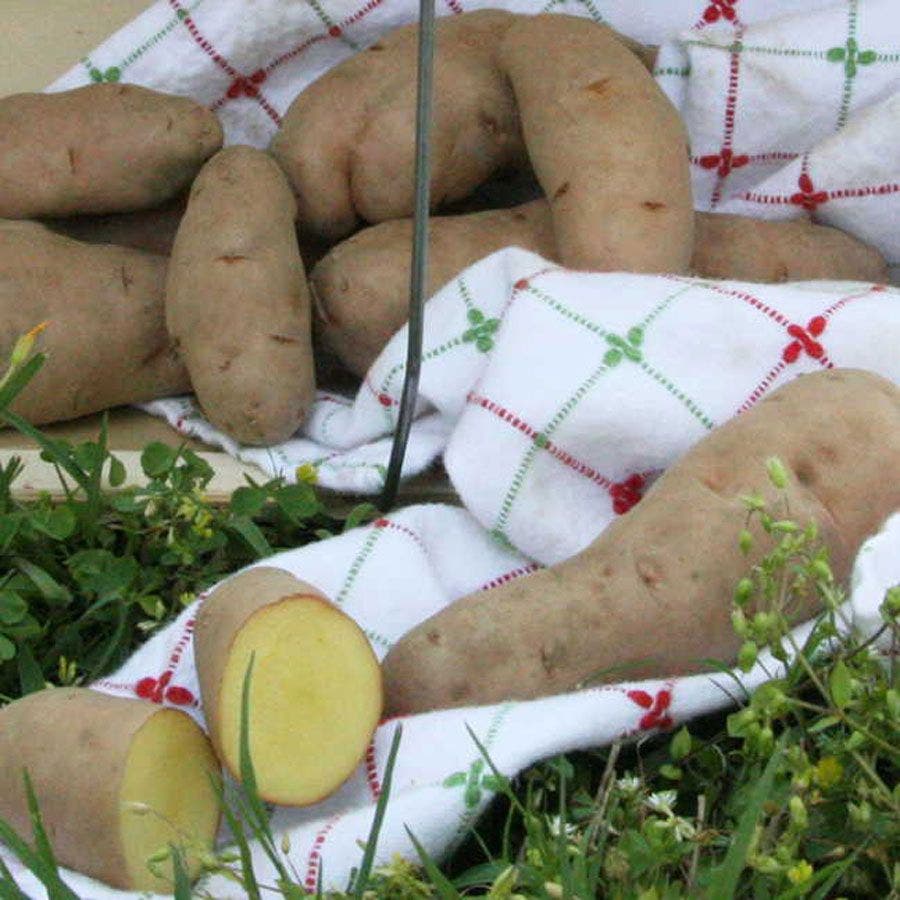'Rose Finn Apple' Potato - 2 Pound Bag
'Rose Finn Apple' Potato - 2 Pound Bag
Zone compatibility details
Understanding the Prices on Our Product Pages
When shopping on our site, you might notice different types of prices listed for products. Here’s a quick guide to help you understand what each price means:
- Regular Price: The price before any discounts, typically reflecting the median price from the past 90 to 180 days, excluding special promotions and clearance events.
- Now Price: The updated price of an item after a reduction from the regular price. Now Prices are often limited to a short time frame and offer the opportunity to save.
- MSRP: Manufacturer's Suggested Retail Price, provided by the manufacturer as a benchmark to highlight the value of our current pricing.
Please note that product prices are subject to change without notice.
Couldn't load pickup availability
Your ZIP code ✎
Zone compatibility details
This variety’s zone range
—
My hardiness zone
—
The USDA hardiness zones offer a guide to varieties that will grow well in certain climates. Each zone corresponds to the minimum winter temperatures experienced in a given area. Make sure that your hardiness zone lies within the zone compatibility range of this variety before ordering.
Fall Shipping Schedule
Fall Shipping Schedule and Zone Opening Earliest Ship Dates
| Shipping For | Earliest Ship Dates |
|---|---|
| Zones 1–6 | Most products begin shipping mid-September |
| Zones 7–13 | Most products begin shipping late September |
| Peony | Begins shipping early October to all zones |

Grow Zone
2 - 11
Mature Height
24
Mature Width
Sun / Shade
Full Sun
Bloom Size
need bloom size meta
Tomato Fruit Set
Days To Maturity
110
Fruit Weight
Soil Tolerance
Normal, loamy
Moisture
Description / 'Rose Finn Apple' Potato - 2 Pound Bag
Days to Maturity: 90 to 110 from direct sow
The most popular fingerling, and one bite will tell you why. 'Rose Finn Apple' Potato is an heirloom variety with mouth-watering little finger-shaped spuds 2 to 5 ounces each and stuffed with savory flavor. A midseason variety, it matures in late summer and can be used as a boiler, baker, or fryer. Just don't add butterthis rich spud already has more scrumptious goodness than it knows what to do with.
Part of 'Rose Finn Apple's great appeal comes from its looks. The skin is thin and pale pink, and the flesh a creamy yellow that promises to be rich and moist. Much smaller than traditional potatoes, these fingerlings are gourmet treats that are every bit as easy to grow as big ole plain brown types.
The plant reaches just 12 to 18 inches tall but spreads up to 4 feet wide, and each 1-pound bag of tubers will sow up to 25 feet of row and yield 20 to 30 pounds of potatoes.
Like all potatoes, 'Rose Finn Apple' fares best in sandy, enriched soil, but if you have heavy or clay soil, just use a raised bed or plant the tubers more shallowly, mulching them well with straw.
Seed Potato Definition:
A tuber that has several eyes whose purpose is to be planted.
Genetically identical to the parent potato.
A faster way to grow potatoes vs seed.
Guaranteed virus free and disease free stock.Here's How to Grow Them:
If your soil is normal to sandy, work in some gypsum and Epsom salts before planting, then set the tubers 3 or 4 inches deep and about a foot apart. (If your soil is heavier, plant more shallowly and rely on mulch rather than soil for coverage.) Potato tubers should be planted in early spring, at the same time as you sow your green peas. If a late frost threatens, just toss a few inches of straw or other mulch over the young plants, and chances are they'll be fine.
When the shoots emerge, you may want to sow some bush beans alongside the young plantsthey'll keep the bugs down. Basil and Summer Savory are also fine companions that keep insects at baywe usually just wait to see which potatoes didn't sprout, and fill in the gaps with these helpful herbs. (Of course, Marigold, friend to all vegetables for its ability to destroy more nematodes than commercial repellents, is always a beautiful choice too.)
Potatoes tend to grow their fruit right under the soil, and over time the tubers may stick out above the soil line. This can cause greening, which ruins the flavor (and adds toxins to the Potato), so watch your plants and add more soil, straw, or peat moss as necessary to keep the taters under wraps. The plants may also bloom, and small, hard green fruits will appear when the flowers pass. Don't be tempted to harvest themthey're toxic.
When it's time to harvest, begin at the outer edges of each plant and work your way in. You want to gently turn over the soil using a garden fork or blunt-edged spade, to avoid cutting into the potatoes. Store the spuds, unwashed and not touching one another, in a totally dark, cool place, where they'll last for several weeks. (You can eat them after they've sprouted; just cut away the inedible sprout and its eye.) Once you've harvested the crop from end to end, begin in a new spot and work your way through it from a different direction. You'll be amazed at how many spuds you missed the first time.
If you love potatoes of all types, take a look at 'German Butterball'. We've also got an exotic blue-skinned variety, the all-purpose Caribe.
Product Details
SKU: 33713
Genus: Solanum
Species: tuberosum
Variety: 'Rose Finn Apple'
Item Form: Bareroot
Light Requirements: Full Sun
Soil Type: Normal, loamy
Uses:- Beds
- Cuisine
- Outdoor
- Edible
State Shipping Restrictions: GU, HI, ID, MT, PR, VI
